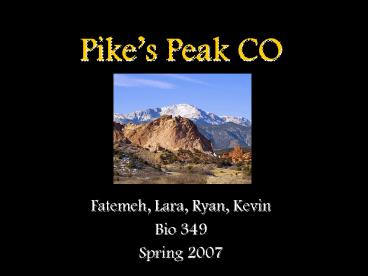Pikes Peak CO - PowerPoint PPT Presentation
1 / 12
Title: Pikes Peak CO
1
Pikes Peak CO
- Fatemeh, Lara, Ryan, Kevin
- Bio 349
- Spring 2007
2
The Question
Your lab partner Scott went to Colorado during
Spring break. While there, he drove to the top of
Pikes Peak to walk around and see the sights,
but had to sit down to rest three times. The last
time was in the weather station, where he glanced
at the barometer. It read 450 mmHg. Complete the
table of cardiopulmonary parameters at sea level
and explain your predictions for the direction of
change (increase, decrease, no change) that take
place by the time Scott enters the weather
station, as compared with the values that he had
at home in Bellingham.
3
Gas Exchange is by Diffusion
The net rate of diffusion is largely influenced
by the pressure gradients (PO2 and PCO2 across
the respiratory membrane).
Alveolar air does not contain the same amount of
O2 and CO2 as atmospheric air because of the
anatomic dead air space.
At equilibrium, alveolar PO2 will equal blood PO2.
4
Diagnosis?
- Scott is possibly experiencing moderate Acute
Mountain Sickness (AMS) due to his desire to sit
down to control dizziness, fatigue, nausea he may
be experiencing. - AMS occurs commonly above altitudes of 8000 ft.
- Pikes Peak maximum elevation is 14,115 ft.
5
Need to know
- Atmospheric air contains 21 O2, therefore PO2
.21 x atmospheric pressure X mm Hg. - But atmospheric air mixes with residual air in
the anatomic dead air space, so alveolar PO2 is
less - Hemoglobin O2 saturation depends on the rate of
diffusion at alveoli - This, in turn, depends on arterial PO2
- Changes in effort during ventilation effort may
be accomplished by a change in rate and/or a
change in tidal volume - If minute respiratory changes in an effort to
maintain normal O2 levels, CO2 levels will also
change - With an effect on pH
6
Bellingham vs. Pikes Peak
7
Whats Happening
- At sea level, carbon dioxide acts on the
peripheral chemoreceptors of the carotid arteries
and aortic arch and on central chemoreceptors in
the respiratory center of the medulla. - When ascending up a mountain, the barometric
pressure and partial pressure of oxygen
decreases. - When oxygen becomes less concentrated, we have a
greater need for ventilation.
8
Consequences
- If Scott cannot acclimatize, the combination of
high altitude and low air pressure will cause
fluid to leak from the capillaries causing fluid
build up in the lungs and brain. - Fluid build up in the lungs is termed High
Altitude Pulmonary Edema (HAPE) and fluid build
up in the brain is termed High Altitude Cerebral
Edema (HACE).
9
Prevention
- To prevent AMS, one should decrease activity
(rest), increase fluid intake to prevent
dehydration, and descend. - Before climbing, one should plan acclimatization
camps at different elevations.
10
Analogy
- Pressure of an upcoming exam
- The pressure gets worse as the exam date moves
closer which forces you to be more productive and
study and learn more - This is analogous to the increase in altitude.
- As the altitude increases, the amount of oxygen
in the air decreases, placing stress on your
body, which causes your body to work harder to
carry more oxygen to your tissues.
11
References
- http//www.destination360.com/north-america/us/col
orado/pikes-peak.php - http//www.lib.mcg.edu/edu/eshuphysio/program/sect
ion4/4ch6/s4ch6_21.htm - http//www.med.howard.edu/anatomy/gas/wk7/Barorece
ptor.gif - http//www.biosci.ohio-state.edu/patches/eeob410/
respiratorylecture.htm - http//www.high-altitude-medicine.com/AMS-medical.
html - http//www.alanarnette.com/alan/everest2006.php
- http//www.coloradoguy.com/williams-waldo-canyon.h
tm - http//www.bio.davidson.edu/courses/anphys/1999/Yu
si/adaptation.html - http//www.ilo.org/encyclopedia/?dnd857100051pr
evDoc857000009 - http//www.altitudephysiology.org/oxygenphysiology
/everestfacts/oxygencalculatorhighaltitude.htm - http//www.bio.davidson.edu/courses/anphys/1999/Yu
si/adaptation.html - http//www.healthatoz.com/healthatoz/Atoz/common/s
tandard/transform.jsp?requestURI/healthatoz/Atoz/
ency/respiratory_alkalosis.jsp
12
References
- http//www.healthsystem.virginia.edu/Internet/Anes
thesiology-Elective/airway/ventilation.cfm - http//www.brooksidepress.org/Products/Military_OB
GYN/Library/MilitaryTexts/GMOManual/GMOManual.htm - http//www.lakesidepress.com/pulmonary/papers/eq/e
qal.html - http//www.lakesidepress.com/pulmonary/papers/eq/e
qal.html - http//jp.physoc.org/cgi/content/full/546/3/921
- http//www.portfolio.mvm.ed.ac.uk/studentwebs/sess
ion4/61/altdet.htm - http//www.lakesidepress.com/pulmonary/papers/eq/e
qal.html - http//hypertextbook.com/facts/2001/LaurenCalabres
e.shtml - http//www.altitudephysiology.org/oxygenphysiology
/everestfacts/oxygencalculatorhighaltitude.htm































